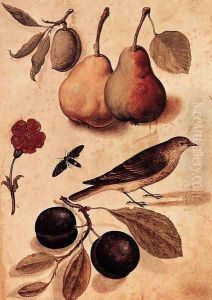Ulisse Aldrovandi Paintings
Ulisse Aldrovandi was an Italian naturalist, scholar, and physician, renowned for his contributions to the field of natural history and for being one of the first to recognize the necessity for systematic study of the natural world. Born on September 11, 1522, in Bologna, Italy, he came from a noble family. He initially studied humanities and law at the universities of Bologna and Padua. However, his academic pursuits were disrupted when he was accused of heresy in 1549, for which he was acquitted but spent some time under house arrest.
After this period, Aldrovandi turned his interests towards philosophy and logic, but his life’s work truly began when he shifted his focus to medicine and the study of natural science. He graduated with a degree in medicine from the University of Bologna in 1553 and subsequently became a professor there. Throughout his career, Aldrovandi assembled one of the most impressive cabinets of curiosities, an extensive collection of natural specimens that included plants, animals, minerals, and fossils.
Aldrovandi is often credited with laying the groundwork for modern natural history. He was one of the first to use illustration as a means of documenting specimens, and he sought to classify organisms into hierarchical categories, though his methods did not have the lasting impact of later classification systems like that of Carl Linnaeus. Aldrovandi’s works were prodigious; he published numerous volumes on natural history, covering topics such as ornithology, entomology, and botany. Among his most notable works is 'Monstrorum Historia', a catalog of natural anomalies, which reflected the Renaissance fascination with the marvelous and the strange.
Despite his significant contributions to natural history, many of Aldrovandi’s texts were published posthumously, and his impact was not immediately recognized. He continued to teach and expand his collections until his death on May 4, 1605, in Bologna. His legacy lived on through his extensive library and herbarium, which were bequeathed to the city of Bologna and later became the nucleus for the city’s botanical garden. Aldrovandi’s work is often seen as a bridge between medieval scholarship and the empirical investigations that characterized the Scientific Revolution.
